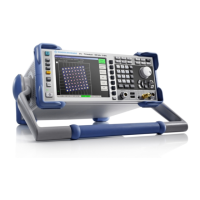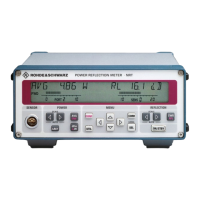Cable Measurements R&S FSH
1309.6275.12 4.68 E-2
Preselecting the cable length:
The R&S FSH uses the cable length to determine the optimal span for the measurement. The longer
the cable under test is, the smaller the span used by the R&S FSH. The R&S FSH also calculates the
cable attenuation from the selected cable model and the length setting so that the magnitude of the
r
eflection at the fault is measured correctly. If the graphics display mode is selected for the results, the
R&S FSH scales the x axis so that it represents the total length of the cable.
If the entered cable length is less than the actual cable length, the R&S FSH does not display the faults
of the complete cable. A reflection at the end of the cable will not be shown. However, deliberately
entering a cable length that is too short is a good way of increasing distance-to-fault accuracy for a fault
that is near to the measurement plane. If the entered cable length is greater than the actual length, the
measured values for lengths beyond the cable length are useless because they are caused by multiple
reflections. If the length of the cable is not known precisely, it is best to enter a length that is about 20 %
to 50 % greater than the best estimate of the cable length.
Press the CABLE LENGTH softkey.
The R&S FSH opens the cable length (CABLE
LENGTH) value entry box and displays the current
length setting in meters or feet. The unit of length is
selected by, and depends on, SETUP: INSTRUMENT
SETUP: LENGTH UNIT.
Using the numeric keys, enter the cable length in
meters and terminate the entry with the ENTER
key, or
Using the rotary knob (1 m steps) or the cursor
keys (10 m steps) adjust the cable length.
The minimum cable length is 3 meters (about 10 feet). This value is determined by the maximum
frequency range of the R&S FSH. A cable length of max. 1500 m (about 5000 feet) can be entered. The
maximum cable length that is suitable for measurements depends on the cable attenuation. Since the
test signal must be twice routed through the cable, the signal reflected at the cable end arrives with
twice the cable attenuation in attenuated form at the input of the power divider. Dynamic range
decreases with increasing cable length.
If the cable attenuation exceeds 10 dB, the R&S FSH
outputs a warning indicating that the cable attenuation
is too high. It also indicates the maximum
recommended cable length for obtaining accurate
results.
Pressing CONTINUE accepts the entry.
Selecting the frequency range
In the default setting, the R&S FSH automatically selects the frequency range around the set center
frequency on the basis of the cable length and cable model. The R&S FSH selects a frequency range
that enables maximum length resolution.
Particularly with relatively short cables, the frequency range in which the cable is specified may then be
exceeded. Therefore, the R&S FSH allows the user to define the frequency range in which the distance-
to-fault measurement is carried out. However, the length resolution of the measurement is reduced by
using smaller frequency ranges.

